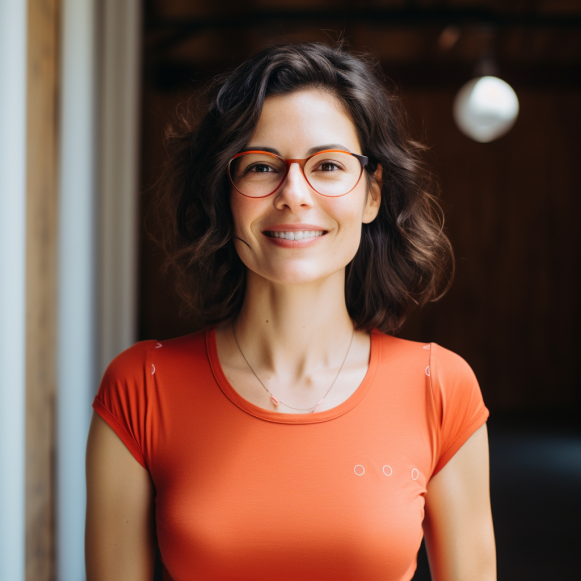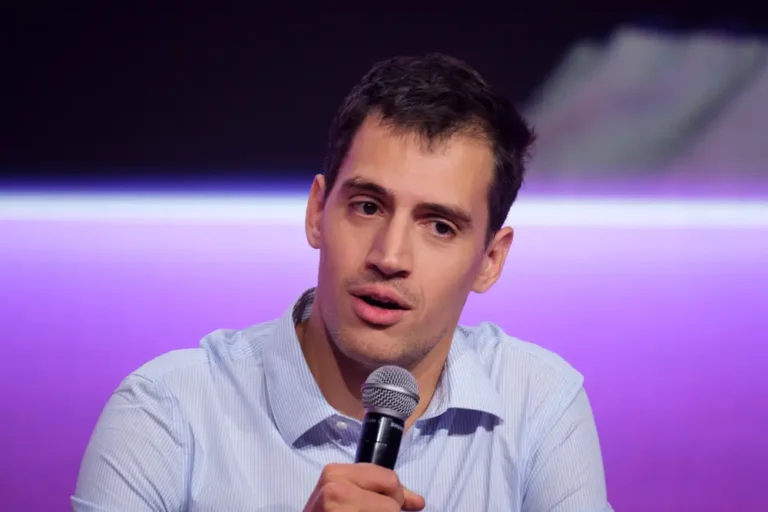A continuous glucose monitor helped me discover I have hypoglycemia. Here’s how startup January uses AI to predict blood sugar spikes and crashes and coached me to better food choices.

- The healthcare startup January uses CGMs and AI to monitor glucose levels, exercise, and sleep.
- The startup has received funding from Felicis Ventures, HAND Capital, and Marc Benioff.
- I have low blood sugar, and January used machine learning to coach me to healthier habits.
The health-and-fitness startup industry is thriving, thanks in part to the growing popularity of consumer devices that track steps, fitness, sleep, menstrual cycles, and other data.
Continuous glucose monitors, or CGMs, remain some of the most invasive and intensive options on the market in this expanding world of health-and-wellness wearables. While the devices, which have traditionally been used by diabetics, provide the ability to monitor blood sugar levels 24 hours a day, they are also costly and require a prescription — plus, many require reapplying the device with a microneedle to the back of the arm every one to two weeks.
This is where January AI comes into play. The startup, founded in 2017 by Noosheen Hashemi, promises a future of glucose monitoring with just one CGM. Wear it for five days, connect a fitness tracker, and the app predicts blood-sugar spikes and dips based on food consumption, exercise levels, and time of day.
In an interview with Insider, Hashemi stated that blood glucose levels are an important health indicator that can help people prevent diseases later in life.
“I wanted to have a more complete picture of one’s health than just what a doctor will tell you because as we wait, the options for treatment become fewer and further apart,” she explained. “Powerful monitors have the potential to improve people’s health.” Today’s healthcare is focused on illness, not health, so we’re attempting to focus on that.”
The startup has raised $28.3 million in funding from HAND Capital, SignalFire, AME Cloud Ventures, and Felicis Ventures, as well as well-known angel investors such as Marissa Mayer and Marc Benioff.
While removable fitness trackers like Fitbit, Whoop, Oura, and even the Apple Watch have long dominated the wearable world, CGMs remain a relatively small niche, with startups like Levels and Nutrisense allowing users to track their blood-sugar levels to monitor for diabetes and manage weight.
January, which emerged from the shadows in 2020, piqued my interest because it promises to provide deeper health insights without requiring users to always wear a CGM.
For more than a month, I used January’s platform, which included five days of AI training while wearing the CGM, followed by weeks of machine-learning-generated data about my food and movement habits. Spoiler alert: The startup gave me useful health recommendations that I’ll be incorporating into my daily life, and it assisted me in identifying and managing hypoglycemia.
To review for this story, January provided me with a CGM and access to the startup’s app. For the first month of service, the startup charges $288, which includes a telehealth evaluation, a starter CGM, and AI calibration. The app’s membership fee after that is $28 per month.
After a medical professional reviewed my intake form, I received a Libre FreeStyle 2 GCM
My January journey began with an online health assessment in which I answered questions about my current health conditions, medications, medical history, and allergies. Following a review of my evaluation by a physician licensed in my state, I was approved for a CGM prescription, which was mailed to me.
CGMs constantly monitor blood glucose (or blood sugar) levels. Unlike glucometers, which test blood sugar levels via blood pinpricks, a CGM is typically worn on the back of the arm and must be replaced every seven to 14 days, depending on the model. The first CGM was approved by the Food and Drug Administration in 1999, and in recent years they have become more accessible and less expensive, leading to increased use by consumers and healthcare startups outside of diabetes management.
Mike Snyder, January’s other cofounder and the director of genomics and personalized medicine at Stanford Medicine, told Insider that this new technology is allowing people to see their own health in ways that weren’t previously possible.
“This is a combination of bringing in new technology and utilizing everything,” he explained. “Through monitoring, we can postpone diabetes for a number of years, and those numbers are worsening as people live longer lives.” We’re attempting to steer people away from that path.”
I had never applied a CGM before, but the app seamlessly guided me through the experience
Unlike other CGM startups and wearables, January’s main selling point is that you don’t have to wear one all the time and reapply it every two weeks.
Furthermore, the CGM lacks a “needle” in favor of a thin, flexible filament that is inserted just beneath the skin.
As someone who has a slight aversion to needles — I’m fine with shots and blood draws, but the thought of sticking myself with something makes me nervous — this was all fantastic news. Still, I was nervous about wearing the CGM and paced around the Insider office for several hours before summoning the courage to do so.
The CGM, on the other hand, was surprisingly painless, and I appreciated that the startup’s app included step-by-step instructions — complete with video tutorials — for opening the packaging, assembling the applicator, and applying the patch.
It was a more in-depth setup experience than other wearables I’ve tried
January requires users to connect a fitness wearable to track heart-rate data in addition to using a CGM to track glucose levels. Currently, the app is compatible with three devices: Fitbit, Oura, and Apple Watch.
I’m a runner who wears a Coros Pace 2, so the January team sent me a Fitbit Inspire to review.
The January setup period was more involved than other programs because you’re connecting three different apps and two wearables — the CGM to its app and then to January, and the Fitbit to its app and then to January — and it also took me a few different times of logging in and out of various apps and reconnecting the devices before all the programs were talking to one another correctly. The time investment paid off when I was able to see my heart rate and glucose data in the January app together, but users should be prepared to spend some extra time getting everything connected properly.
My first CGM also fell off after a few days, coming loose when I was pulling my arm through a tight sports bra. January, which promptly sent me another patch to apply as well as sensor covers to add an extra layer of protection, stated that its patches rarely come off.
After the CGM and fitness tracker were synced, January kicked off five days of AI training
January collected my glucose and heart-rate data around the clock during the five-day AI-training period. In addition, I began tracking everything I ate and entering it into a food log in the January app.
The AI training, like the initial setup, was more involved than with other wearables I’ve tried, many of which are much more “set it and forget it.” While CGMs monitor your glucose levels continuously, I had to open the FreeStyle LibreLink app on a regular basis and hold my phone up to the patch to scan for data collected since the last reading, which was then sent to January.
This step is especially important to remember after eating because it allows the app to begin identifying how different foods affect your blood sugar levels in real time.
Meanwhile, the Fitbit integration was ready to go after the initial setup and didn’t require anything else for January to start collecting my heart-rate data.
While using the CGM during the AI training process, I discovered I have low blood sugar
Early on in my time with the January app, I discovered that my blood sugar was consistently at the low end of a healthy range, which, according to Mount Sinai, is between 70 and 100 mg/dL when fasting. Furthermore, even with regular meals and snacks, my blood sugar levels would crash a few times a day, dipping into the low 60s during the day and occasionally as low as 54 mg/dL overnight.
Low blood sugar, also known as hypoglycemia, is less common than high blood sugar, also known as hyperglycemia.
Though I didn’t have to worry about hyperglycemia, learning about my low blood sugar levels helped me understand a set of symptoms I was experiencing on a regular basis: lightheadedness, fatigue, becoming “hangry,” and having shaky hands.
After the training period, you can remove the CGM and continue to receive AI-powered glucose predictions throughout the day.
I unlocked a suite of tools to track my food, exercise, blood sugar, and more at the end of January’s AI training. The startup’s landing page includes a daily health recap that includes my calorie and fiber intake, whether I went for post-meal walks, and how much sleep I got the night before. A large line graph also includes a timeline of my predicted blood-glucose levels, heart rate, and meal and exercise time stamps, giving me a big-picture view of how diet and exercise were affecting my blood-sugar levels throughout the day.
January provided predictions for how certain foods, such as a bag of pretzels, might spike my blood sugar more than others, such as a serving of green beans, when I logged my food. These estimates are generated by AI and are based on data collected by the CGM while I was wearing it and tracking my food during the training period.
January also sent me push notifications throughout the day to keep me focused on my diet and exercise goals. If it was late in the afternoon and I hadn’t yet logged lunch; if I ate a meal but didn’t immediately go for a short walk; or if I met my recommended fiber intake — which can help regulate blood sugar levels.
January launched an AI health coach that was embedded directly within the app during the time I was reviewing the startup. I could ask the digital assistant, “Jan,” various questions about my food choices — such as what to have for dinner, how to eat more fiber, or a suggested weekly meal plan — and it would respond with recipes and information while taking dietary and other preferences into account.
While using the app, I learned some surprising things about my health — and how I could tweak my eating and exercise habits to avoid a midday sugar crash
Even though I had hypoglycemia, the January app informed me that my breakfasts were spiking my blood sugar and leaving me hungry well before lunchtime — and sometimes craving a mid-morning nap. I frequently eat a lot of fruit in the morning to start my day with a good dose of nutrients and fiber, but January’s revelations helped me realize that I was ignoring protein and healthy fats that would keep me fuller for longer and give me enough energy to make it to my next meal.
As it related to my post-meal routine, the startup also helped me stay active throughout the day. I had never considered the timing of my workouts as an avid runner who exercises almost every day, and I can get lazy with movement throughout the day if I complete an hour-long workout in the morning. However, January encouraged me to take a short walk after eating, which can help moderate glucose levels.
One of my favorite aspects of January is that it challenged my perceptions of “healthy” food and encouraged me to make small changes to my existing diet so that I could continue to eat foods I enjoy while minimizing the negative effects on my blood sugar. As an endurance athlete, I used to think about eating little more than three mostly-healthy meals per day, a couple of snacks, and enough fruits and vegetables. As a result, I frequently experienced rapid-onset hunger that sent me from zero to dizzy in minutes, and I was frequently under-fueled for workouts and sluggish after large meals.
With January’s suggestions, however, I began making small changes that helped me feel more balanced with my energy throughout the day.
Overall, I really liked using January and found that its health insights motivated me to make some changes to have more consistent blood-sugar levels
While January is primarily focused on common hyperglycemia and the estimated 130 million diabetic and pre-diabetic Americans, I was still able to learn about my own health, low blood sugar, diet, and exercise. The startup’s recommendations and health coach provided me with actionable steps to improve my eating habits and avoid dips and spikes, and I’ll be implementing these new habits after this review.
However, if you struggle with closely monitoring your food and exercise levels, this may not be the technology for you. Keeping a food diary has been shown to aid in weight loss and healthy eating, and in January’s case, it’s a critical data point for continuing to receive AI-powered predictions about your glucose levels. People who are prone to disordered eating, on the other hand, may not benefit from logging every meal.
The initial setup and AI training require more time and labor than competitors.
However, the payoff is very high, especially because the startup is using AI to provide a great digital-health experience after the setup process. The CGM market is currently booming as devices become more affordable and digital-health startups seek to capitalize on the power of blood-glucose tracking.
In that regard, January is a game changer — while I was pleasantly surprised that using the CGM didn’t hurt, I was even happier knowing that I wouldn’t have to apply a new one every two weeks to continue using the app.






